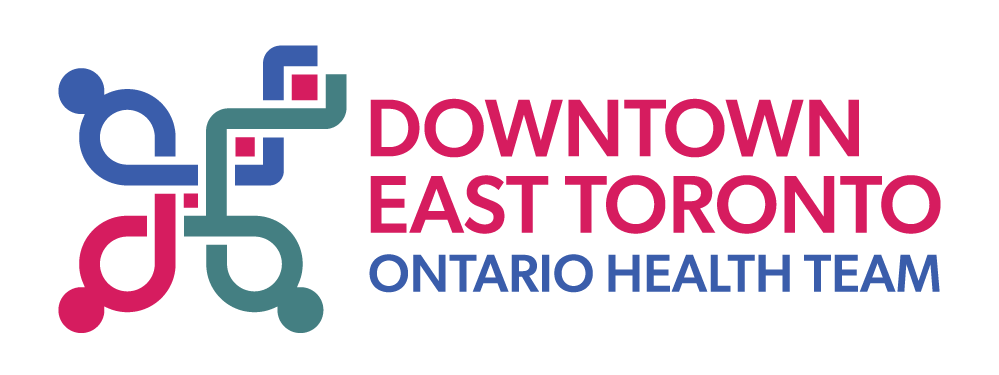This news story concludes a two-part series on the Stepped Care Pilot (read part one). We had a conversation with two family physicians, Dr. John Goodhew and Dr. Curtis Handford. We wanted to learn about their perspectives on how the Stepped Care model makes it easier for patients to access mental health support and services. Handford is the Medical Director of the Primary and Community Care Program at Unity Health’s St. Michael’s Hospital site. He also leads the Downtown East Toronto Family Physician Network. Goodhew is a primary care physician specializing in care and treatment of people living with and at risk of HIV and the larger LGBTQ+ community. Both Handford and Goodhew were involved in the design and implementation of the Stepped Care Program.
Dr. John Goodhew can now spend more time assessing his clients seeking mental health support. Instead of grappling with the administrative hurdles of finding the right service, he now contacts a mental health navigator. This navigator, part of both the Stepped Care Program and St. Michael’s Hospital Seamless Care Optimizing the Patient Experience (SCOPE) Program, assists in guiding his clients to the appropriate support they need.
Goodhew’s clients have also found it helpful to have a navigator manage their case while waiting for formal counselling. Wait times are unavoidable. However, when a mental health professional reaches out to support clients and reassure them that things are moving forward, it makes waiting easier.
“It’s like waiting for an MRI or anything else. You know it’s going to be a long wait,” says Goodhew. “The mental health navigator checks in with people and lets them know they haven’t been forgotten, and that it is going to happen.”
With a trained navigator providing brief therapy during the waiting period, Goodhew notes his clients are more confident. They believe the service they receive eventually will be the best match for their condition.
After years of practice, he recognizes that no single physician can be familiar with all available services. In a system functioning in silos, accessing services becomes increasingly difficult. Each organization often has its own specific eligibility criteria.
“When you have a patient sitting next to you and they are looking for counselling services, you have a couple of programs that you would frequently refer,” he says. “But you are not always confident it is a good fit.”
Dr. Curtis Handford echoes this sentiment when discussing the available support and services.
“There is a shortage of mental health resources that are publicly available or at least of reasonable cost. In addition, there is a very difficult course to navigate in order to access what is available,” says Handford.
There are even greater struggles in matching tailored mental health supports for equity-deserving clients. When physicians have to juggle clients, paperwork, and specialist referrals, they often have little time left. This leaves them unable to adequately address the unique needs of Black, Indigenous and racialized people, those with disabilities, and LGBTQ+ communities.
Unlike other care models, Handford says the Stepped Care Model offers personalized navigation to each client. He points out that while some clients are adept at self-advocacy and navigating, many others face challenges and fall through the cracks. Therefore, in managing the details of each case, the navigator invests time in understanding the care goals of every client.
Given the long wait times and increasing shortage of health human resources, it has become crucial to use the existing resources effectively and triage clients based on the level of urgency. Waiting without any kind of intervention makes urgent clients even more vulnerable.
In Goodhew’s experience with the program, one of his highly urgent clients was able to receive brief intervention during the waiting period. He says the results were tremendous. Only six counselling sessions made a significant difference to his client’s mental health. Although the client still awaits a longer set of therapy, he has now found himself in a better place.
Goodhew believes this could not have been possible without navigation accuracy, and it goes both ways. Clients should be going to an organization that can meet their needs and organizations should be receiving clients that are appropriate to them.
“When you have that accuracy and connection between the right patient – who is triaged – and the right organization, it is a win all around the table.”
Efficient capacity utilization can make such triage possible, especially for the most vulnerable individuals.
When the navigator undertakes the task of determining urgency levels and finding referrals, it encourages more providers to collaborate, thereby making room for new clients. Given the limited new resources and capacity in the healthcare system, the navigator is a catalyst in strengthening existing working relationships and system connections within the DET OHT.
Handford and Goodhew say the value of the Stepped Care Model is to bring clients to the right place at the right time ‘the first time’. Although breaking down silos and building effective care pathways remain a long journey, more family physicians and mental health organizations can make lasting progress by actively participating in the program.
If you would like to learn more about how your organization can participate in the SCOPE and DET OHT Stepped Care program, please contact [email protected].

